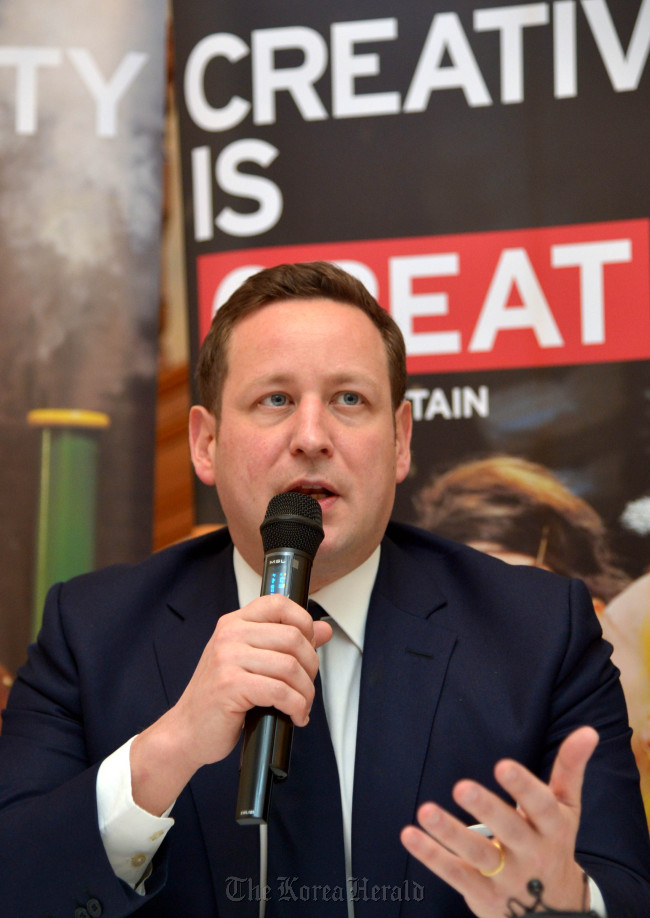Global network fosters success of creative industry: U.K. minister
By Korea HeraldPublished : March 11, 2013 - 19:44
The 2012 London Olympics Opening Ceremony was a new chapter for the so-called creative industry. It was the moment when creativity beat big-scale, blockbuster conventionality.
A huge group of dancers performed a running storyline and the Olympic Flame was lit in a flower-shaped cauldron, while everyone sang along to “Hey Jude” with Paul McCartney: It was not as lavish or grand as the Beijing opening ceremony, but more of a condensed, cool and witty celebration.
On Monday, Ed Vaizey, U.K. minister for culture, communications and creative industries, arrived in Korea with a group of creative industry delegates from both the public and private sectors to exchange ideas on future collaboration of soft power.
Vaizey, here for four days, seemed more than pleased to see the traits of British creative content in faraway Korea.
A huge group of dancers performed a running storyline and the Olympic Flame was lit in a flower-shaped cauldron, while everyone sang along to “Hey Jude” with Paul McCartney: It was not as lavish or grand as the Beijing opening ceremony, but more of a condensed, cool and witty celebration.
On Monday, Ed Vaizey, U.K. minister for culture, communications and creative industries, arrived in Korea with a group of creative industry delegates from both the public and private sectors to exchange ideas on future collaboration of soft power.
Vaizey, here for four days, seemed more than pleased to see the traits of British creative content in faraway Korea.

“It was great for me to be at the Incheon International Airport designed by British architect Terry Farrell. We will be going to Dongdaemun (Design Plaza & Park) later on designed by Zaha Hadid and I’ve learned British musicians like Adele and TV programs such as ‘Sherlock’ were well known in South Korea,” Vaizey said in a press conference in Seoul.
“Equally, South Korean culture is becoming better known in the U.K. Obviously Psy and Gangnam Style is now known to everyone from my 5-year-old son to my grandparents. South Korean visual arts were shown at the Liverpool Biennale a couple of years ago and design arts are well known in the U.K.,” he added.
Vaizey’s visit came amid heightened public anxiety over the soon-to-be established Ministry of Future Planning and Science here, which puts the creative industry at the forefront. President Park Geun-hye announced that science and creativity will be the main keys to the country’s prosperity and the ministry is seen as her pet project.
Vaizey and John Sorrell, chief executive and chairman of the London Design Festival and co-chair of the Sorrell Foundation, both agreed that the creative industry could be a growth engine.
“The government has figured out that the creative industry was a valuable contributor to the economy not only in terms of money but in terms of jobs. And over the past 15 years, governments and cities all over the world have been looking into fostering the industry,” he added. The creative industry is currently believed to involve more than 1.5 million people, creating 36 billion pounds in economic value every year in Britain. It is considered equivalent to or better than the finance industry, the spine of the British economy.
Vaizey said that several factors could contribute to the acceptance of the term creative industry and its effects in the country.
“Skills, dedicated schools including universities; linking the arts with technical skills, which have been promoted in the U.K.; and giving good access to financing as well as the intellectual property rights will be the key issues,” he said.
“In today’s global economy where the creative industry makes up 7 percent of the world’s GDP. It’s the power of ideas, of innovation, of creativity and of design adding value that will bring growth, economic success,” he said.
“We have a favorable tax regime for not only the film industry but also TV, animation and video games. The government values the creative industry and its role in the economy,” he said.
By Bae Ji-sook (baejisook@heraldcorp.com)
-
Articles by Korea Herald








![[KH Explains] How should Korea adjust its trade defenses against Chinese EVs?](http://res.heraldm.com/phpwas/restmb_idxmake.php?idx=644&simg=/content/image/2024/04/15/20240415050562_0.jpg&u=20240415144419)











![[Today’s K-pop] Stray Kids to return soon: report](http://res.heraldm.com/phpwas/restmb_idxmake.php?idx=642&simg=/content/image/2024/04/16/20240416050713_0.jpg&u=)